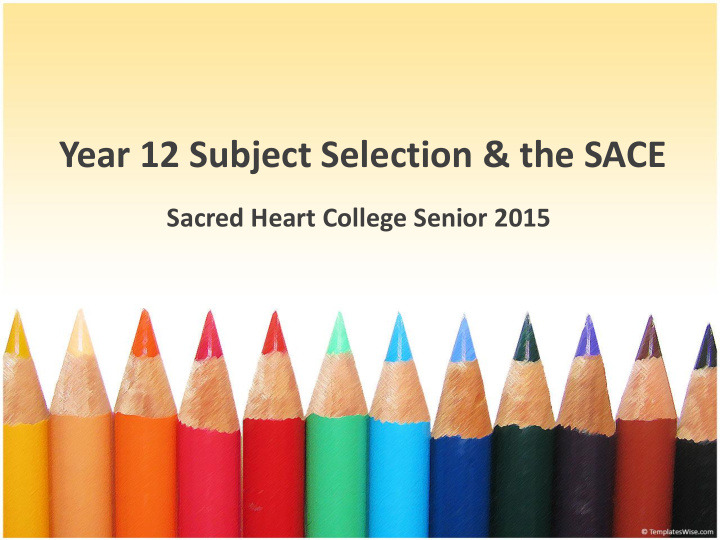



Year 12 Subject Selection & the SACE Sacred Heart College Senior 2015
What is the SACE? • The South Australian Certificate of Education • A qualification awarded to students who successfully complete their senior secondary education (Years 11 and 12) • Recognised nationally and internationally • Used for entry into universities and further training • SACE Board of SA – oversees the certificate
SACE – some of the basics… • Stage 1, Stage 2 • Credit points • 10 credits = 1 semester • SACE grades • A to E for Stage 1 subjects • A+ to E- for Stage 2 subjects
SACE Assessment • Stage 1: 100% school assessed • A to E grades • Stage 2: 70% moderated teacher assessment, 30% external assessment • A+ to E- grades • Performance Standards
SACE Requirements • Credit points • Minimum 200 credits to achieve SACE • 10 credits = 1 semester \ 20 semesters • 60 Stage 2 credits (C- grade or better) • Within Stage 1 and 2, there are an additional 50 compulsory credits
SACE Requirements Compulsory elements • Must achieve C or better for compulsory elements • Personal Learning Plan • Stage 1, 10 credits • Completed at Year 10
SACE Requirements Compulsory elements • Must achieve C or better for compulsory elements • Literacy and Numeracy • Stage 1, 20 credits Literacy • Stage 1, 10 credits Numeracy • Completed at Year 11
SACE Requirements Compulsory elements • Must achieve C or better for compulsory elements • Research Project • Stage 2, 10 credits, C- or better • In-depth study of topic of interest • Research and presentation skills • 70% internal assessment, 30% external
SACE Criteria to Meet in Yr 12: (If C or better for all Stage 1 compulsory subjects) • 60 Stage 2 credits – equivalent to 3 full year subjects (must get C- or better) • Research Project (10 credits – must get C- or better) • Minimum 200 credits total
Eligibility for University Entrance • Complete the SACE • Gain 90 Stage 2 credits – Tertiary Admissions Subjects (TAS) – this is NEW • Including 3, 20-credit subjects • “Prerequisite” requirements & “assumed knowledge” • Comply with “counting restrictions” and “precluded combinations” • Obtain an ATAR – Australian Tertiary Admission Rank
Calculating the ATAR Scaled scores from 3, 20-credit TAS (60 credits of Stage 2 full year subjects) + 30 additional credits of other Stage 2 TAS subjects or Recognised Studies = University Aggregate out of 90 The University Aggregate is then converted to a percentile ranking (relative to the performance of other students) – the ATAR
Moderation and Scaling • 70% teacher assessment - moderated • Overall subject grade is scaled purely to calculate the ATAR • Scaling - comparison of performance for subjects with different objectives, content, assessment processes • Average for Subject A same as Subject B for students doing both (common candidature)
Should scaling affect subject choices? • Scaling is not consistent • It can be observed that scaling does not impact high grades as much as lower grades • It is possible to get a better score for a subject that is scaled down than a more challenging subject that is scaled up • Keep strengths in mind
Choosing Year 12 subjects • Pre-requisites for Year 12 subjects • Some subjects must have done 20 credits Year 11 • Some subjects must have done 10 credits Year 11 • Some subjects no pre-requisites • Research subjects • Bonus points • Off-site subjects, University subjects • Workplace Practices (including VET)
Community Learning • Self-directed Programs • Community-developed Programs • www.sace.sa.edu.au/subjects/recognised-learning/community-learning • Up to 90 credits can count towards SACE • Doesn’t count towards ATAR
Special Provisions • Illness, learning difficulty, disability or unforeseen circumstance interrupts student’s ability to complete assessment tasks • Evidence/documentation required • The same knowledge, skill requirements and standards are applied • Flexibility relating to the conditions under which the assessment task is completed • Student must negotiate changes to assessment with his/her teachers
SACE Board Website Visit the SACE Board website – particularly the “Students and Families” and “Subjects” sections : www.sace.sa.edu.au
The Subject Selection Process • 4 week process • Folders distributed, information session, email with slide show & WebChoice instructions • Parent night • Subject selection due date: Thurs Aug 21 st • What happens after the form goes in? • Not set in stone – can make changes • Beware: the later the change, the less choice there is! It pays to get it right the first time. • Promotions
Credits Compulsory Subject The Research Project (one semester) 10 Indicate below your FULL YEAR subjects Speci cialis alist Maths Preference 1 20 Maths Studies es Preference 2 20 Physics cs Preference 3 20 Chemist stry ry Preference 4 20
Credits Compulsory Subject The Research Project (one semester) 10 Indicate below your FULL YEAR subjects English sh Studies es Preference 1 20 Visual al Art (Design gn) Preference 2 20 Visual al Art (Art) Preference 3 20 Photogra graph phy Touri rism sm Preference 4 20
Credits Compulsory Subject The Research Project (one semester) 10 Indicate below your FULL YEAR subjects English sh Communi nicat cation ons Preference 1 20 Communi nity ty Studies es Preference 2 20 (Trad ade e Maths) Furnitur ure e Constru ruct ction on Preference 3 20 Workplace ace Pract actices ces Preference 4 20
Credits Compulsory Subject The Research Project (one semester) 10 Indicate below your FULL YEAR subjects English sh Communi nicat cation ons Preference 1 20 Integra rated ed Learn rning ng (Fitness, ss, Preference 2 20 Heal alth & P Physica cal Activity) y) Furnitur ure e Constru ruct ction on Preference 3 20 Workplace ace Pract actice ces Preference 4 20
Please contact Karen Bailey (Director of Teaching & Learning), Gail Morgan (Assistant Principal – Curriculum), Prue Wilkosz (Pathways Coordinator), subject teachers or your child’s Homeroom teacher if you have any questions about subject selection.
Recommend
More recommend